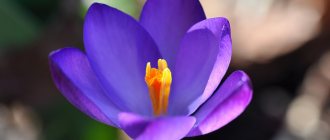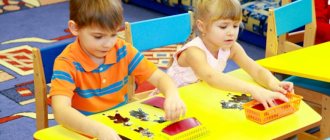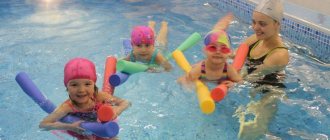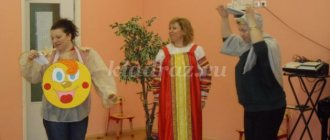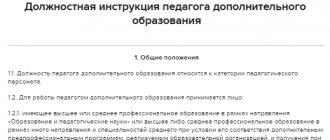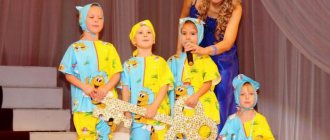Theoretical aspects of organizing circle work in junior groups of preschool educational institutions
The key problem of any educational process is achieving a balance between effective group work and an individual approach to each child. From early childhood, as soon as a child leaves the family for society, a nursery, a kindergarten or other forms of preschool educational institutions, he becomes part of an organized pedagogical process. Such a system is designed to save the strength and effort of society, and the teacher works with a certain age group according to an approved general plan. The downside of this approach to the organization of education was its mechanistic nature, its similarity to a continuous production cycle, a conveyor.
For a thoughtful teacher, a unique dilemma is always the degree of possible departure from the plan to improvisation, which is often appropriate and even necessary when working with children. For parents, the problem becomes solving the question of how to adapt the child to the demands of society, without breaking his individuality, without causing trauma due to the difficulties of inevitable socialization. For the child himself, these difficulties of adults, which he is not aware of, are expressed much more simply: how to make learning become interesting, so that it is good and not boring. The answer to these requests is often an activity that sometimes even teachers themselves tend to consider additional, secondary, that is, secondary. This is the free creative activity of children within the framework of various clubs and additional activities, in which the desires and inclinations of the child and his own positive motivation are of decisive importance. You need to engage in this creative work already at an early preschool age, carefully noting the child’s inclinations and aspirations for one or another type of activity.
Exciting group activities facilitate the process of adaptation of a child to the conditions of a preschool educational institution
The goals of the circle work are varied, and they all work to develop the child and improve his speech, social and cognitive skills. Another important goal of working with a child is his physical development and recovery. We must not forget about the psychological side of the matter, because exciting club activities facilitate the process of a child’s adaptation to kindergarten, providing him with the opportunity to freely express his natural talents and open up in a friendly environment. General goals include health and adaptation.
Goals, objectives and methods of circle work in the first junior group
Children aged 1.5–3 years are characterized by a continuation of the process of speech acquisition; difficulties in the development of the speech apparatus, phonetic and speech therapy difficulties may arise. In addition, coordination of movements, fine and gross motor skills (running, jumping, bending, squatting) are not sufficiently developed. At the same time, the child is already actively interacting with an adult, is able to fulfill his simple requests (get up, walk, stop), meaningfully answer questions that he understands and formulate simple questions and requests (give, where, what) independently.
A child’s vocabulary at 1.5 years old starts at 20 words and actively increases every day.
Goals that are most relevant for working with children 1.5–3 years old:
- speech development (vocabulary, speaking, formulating statements),
- development of coordination of movements and motor skills,
- development of cognitive interest and perception (with the help of toys, riddles).
Current tasks of working with children of this age:
- expansion of vocabulary aimed at gaming and social activities, names of actions and objects, greetings and farewells,
- mastering physical activity (running, jumping, squats, throwing a ball),
- mastering spatial concepts (up, down, side, ahead, etc.),
- development of color and shape perception,
- mastering simple perception of time,
- understanding one’s own name and the names of others, the ability to say one’s own name, the names of parents and other people, remembering names.
The main techniques used to achieve the goals and objectives:
- game involvement,
- direct demonstration of one’s actions for children to repeat on objects and objects,
- short conversation,
- showing the object's actions,
- direct instruction-command.
An important technique for pupils of the younger group is the demonstration of actions by the teacher
Goals, objectives and methods of work of the circle in the second junior group
At the age of 3 years, there is a crisis in defending the child’s independence; he constantly tests the boundaries of what is possible (including the patience of the parents). It is during this period that it is extremely important to support the positive achievements of the child and tactfully direct his activities in a direction that is useful for everyone, that is, precisely in those games and activities where the child will maximally develop his abilities, strengthen his health and self-confidence.
The mechanisms of social learning are especially important here, since the child strives to repeat the actions of adults and other children, learns easily and with pleasure through imitation and copying, and assimilation of the observed pattern. At this age, artistic talents also awaken, when the baby happily copies the gait and speech of other people, as well as characteristic behavioral traits.
If at an earlier age a child received almost all information through visual perception, from the age of 3 there is an increase in the channel of auditory information perception through words and sounds, verbal explanations.
Goals of circle work in the second junior group (3–4 years):
- expansion of vocabulary and development of erudition (educational),
- development of memory and attention, understanding of speech and emotions,
- development of a sense of beauty (aesthetic),
- development of the foundations of ethics and interaction with other people (social, moral, educational),
- development of the volitional sphere (self-control and attention, the ability to concentrate on audio or visual information),
- development of motor skills (including fine) and sensory qualities, the ability to express and describe in words the sensations or actions experienced.
Possible tasks for club activities in the second junior group of preschool educational institutions:
- formulating simple sentences,
- description in your own words of the object depicted in the picture, comparison of the image with the real object,
- performing spatial tasks and commands during the game,
- mastering the relationship between part and whole,
- memorizing simple poems and speech phrases by ear, meaningful repetition of heard phrases and expressions,
- mastering games with rules and assigned roles,
- assembling simple construction sets and educational toys from component parts,
- description of actions and sensory sensations within the framework of games and developmental activities.
The development of fine motor skills, and therefore speech, is a priority task for younger preschoolers.
To achieve the goals and objectives in the second junior group, the following methods and techniques are used:
- demonstration of actions using the example of models and layouts of objects,
- conversation-explanation,
- verbal description or simple verbal instructions,
- problem situation (riddle, charade, experiment),
- demonstration of actions using the example of depicted objects and participants,
- a simple game with rules and role-playing restrictions,
- dance.
When conducting circle classes for children, one should take into account the characteristics of children, the rapid growth of changes and the individual uneven development of children in the same group, even if they are of the same age. So, in a group there can simultaneously be children who use only individual words and have difficulty perceiving information by ear, and children who are able to correctly construct a phrase and correctly follow oral instructions for complex spatial actions. The teacher’s task is to take this difference into account and gradually reduce the degree of developmental lag in pupils, including through their additional involvement (within the framework of circle work) in developmental activities.
Topics of club classes in preschool educational institutions
When choosing a topic (subject focus) for a circle in a preschool educational institution, one should proceed not so much from the inclinations of the children, but from the socially desirable areas of activity, the requests of the parents of the pupils for training and development in a particular area. Young children do not yet demonstrate individual characteristics well enough that could help accurately determine their inclinations and talents. In addition, the teacher is responsible for the overall harmonious development of children, so the best choice of thematic focus of circle activities will be one that satisfies either one, but the most pressing need (for example, speech development), or solves several problems at once.
An example of an integrated direction of circle work can be considered a dance and song circle, the activities of which are aimed at the development of speech and health-improving motor activity, the development of motor skills and coordination of movements, the development of aesthetics and patriotism through folk musical culture, etc.
Recommended types of club activities for primary preschool age in kindergarten include:
- Speech development: “talkers”, song club, native speech club (folk culture of the region), speech therapy club.
- Physical development: dance club, swimming club, gymnastics club, children's yoga and breathing exercises (if the teacher has the appropriate qualifications).
- Sensory development: testoplasty, a group of young artists and sculptors, a group of modeling from clay or plasticine.
- Development of cognitive abilities: “intellectual”, “developer”, “knowledge”, a circle of riddles and charades.
Children happily attend dance classes and participate in performances
Club work in the second junior group of kindergarten
The motor skills and emotional-volitional qualities of the pupils of the second younger group are better developed compared to the first group, so they can already be trusted with a little independent work. Children aged 3–4 years have a better developed perception of information by ear; the main method of work is still demonstration, but in addition, verbal instructions and diagrams can also be used, with which children can work independently.
As for working with the first group, educators organizing clubs for the second younger group are recommended to compile their own card index of topics used in the work, and include in it the necessary supporting materials and auxiliary information.
Table: technological map of the cosmonaut circle class
| Class date | ||
| Educator | ||
| Kindergarten group | II junior group | |
| Educational areas |
| |
| Subject | "Space and Man" | |
| Chapter | Construction from cubes | |
| Target |
| |
| Stages of activity | Activities of the teacher | Children's activities |
| Motivational, preparatory |
| Children watch and take an active part in the conversation. |
| Organizational search |
|
|
| Warm-up |
| Imitative physical activity of children. |
| Corrective |
| Take part in the discussion and review their work. |
| At the end of the lesson, the circle participants should |
| |
Lesson time plan
The duration of classes in the second youngest group of preschool educational institutions (children aged 3–4 years) cannot be more than 15 minutes. The central part of the lesson must include elements of physical activity, outdoor play or warm-up. There is no need to do a special warm-up if the course of the lesson itself consists of outdoor games and exercises.
- Introductory stage: preparation and motivation (3-4 minutes).
- Main stage: demonstration or organizational and search activity of children (5–6 minutes).
- Corrective and reflective (4–5 minutes).
During or after the lesson, children can play with the completed crafts.
Materials for the introductory stage of classes in the second junior group
The best material for organizing the introductory stage of classes in the second youngest age group, as in the first, is a game with characters from well-known fairy tales or cartoons. In the second group, verbal conversation can be used more actively, necessarily associated with the display of images. To attract the attention of children aged 3–4 years, it is best to use emotional involvement, to which you can actively add a cognitive-search element (riddle, problem search). At this stage, it is possible to introduce verbal instructions and explanations, fairy tale conversations, and situational role-playing games with children. A good start to a lesson can be a small riddle, a problem, or a fascinating question addressed to children.
Pupils of the second junior group can already be trusted to work independently with supporting and visual material (with a little help and supervision).
Table: options for organizing introductory stages for different topics of the circle classes
| Subject | Introduction |
| Bridge construction | A riddle about how to get a car through a stream. |
| Good words |
|
| Animals in nature | Old Lesovik mixed up the animals' homes and turned to the guys for help in order to untangle the houses and their inhabitants from their tracks. |
| Autumn in nature | Distributing supporting material - autumn leaves for discussion and comparison of changes in nature. |
Examples of lesson notes
- Summary of the lesson “Travel with a Drop” in the “Knowledge” circle (Sparrow M.D.).
- Summary of the lesson “Visiting a squirrel” in the “Semitsvetik” circle (N. G. Lezina).
- Summary of the lesson “Hedgehog” in the “Salty Miracle” circle (Kunichkina O.).
Examples of work programs for clubs in the second junior group
- “Entertaining mathematics” (Ivanova M.I.).
- Speech development circle “Govorushki” (Galushkina Yu. A.).
- Cognitive development circle “Why” (Samsonova E.V.).
Photo gallery: examples of work completed as part of club activities by pupils of the second junior group
During the design classes you can make crafts from waste materials
Pupils of the second junior group can complete simple tasks independently
Ready-made children's works can be arranged into a general composition
Installation on a space theme was completed in several classes
Crafts made in the circle classes can be used in other classes at the preschool educational institution
"Whychki" circle Early age group
Circle
“Pochemuchki”
Early age group
Explanatory note
Of particular importance for the development of a preschooler’s personality is his assimilation of ideas about the relationship between nature and man. Mastering the methods of practical interaction with the environment ensures the formation of a child’s worldview and his personal growth. A significant role in this direction is played by the search and cognitive activity of preschoolers, which takes place in the form of experimental actions.
Children's experimentation is not an activity isolated from others. It is closely connected with other types of activities, and primarily with such as observation and work, speech development, visual activity, physical education; to a lesser extent, experimentation is associated with musical and physical education.
Experimentation acts as a teaching method if it is used to transfer new knowledge to children. It can be considered as a form of organization of the pedagogical process, if the latter is based on the method of experimentation. And finally, experimentation is one of the types of cognitive activity of children and adults.
Entertaining experiences and experiments encourage children to independently search for reasons, methods of action, and show creativity, as they are presented taking into account the current development of preschoolers.
It is rare that a child, regardless of age, during a game - classes, activities - quizzes, does not want to show independence, to be the first smart, knowledgeable, first, to be like an adult! In this sense, selected games and activities can significantly make the “children’s work” (game) joyful and desirable!
GENERAL TASKS OF ORGANIZING SEARCH AND COGNITIVE (EXPERIMENTAL) ACTIVITIES OF PRESCHOOL CHILDREN:
— formation of dialectical thinking in children, i.e. the ability to see the diversity of the world in a system of relationships and interdependencies;
— development of one’s own cognitive experience in a generalized form using visual aids (standards, symbols, conditional substitutes, models);
— expanding the prospects for the development of children’s search and cognitive activity by including them in thinking, modeling and transformative actions;
- maintaining children's inquisitiveness, initiative, intelligence, criticality, and independence.
The work is organized in 3 interrelated areas:
- Live nature
- inanimate nature
- Human
TASKS OF THE "WHY" CIRCLE (EXPERIMENTAL - EXPERIMENTAL ACTIVITIES) IN
THE I JUNIOR GROUP No. 5 "CAMOMILE":
1. To develop the ability to perform actions in accordance with the proposed pictogram. Determine the content of the activity.
2. To develop the ability to consider a phenomenon as a system, a set of stable connections between the components of the phenomenon along the line present - vulgar - future to identify the interconnections of objects of the man-made world (stump stool, chair) or living nature (egg - chicken - hen).
By the end of the year, children should be able to:
1. Perform actions in accordance with the suggested icon. Determine the content of the activity.
2. Consider a phenomenon as a system, a set of stable connections between the components of the phenomenon along the line present - vulgar - future to identify the interrelations of objects of the man-made world (stump-stool, chair) or living nature (egg - chicken - hen).
LITERATURE.
Veraksa N.E. Cognitive and research activities of preschoolers. M.2012
Dybina O.V. What are the objects made of? Games – activities for preschoolers. M.2013
Dybina O.V. The unknown is near. Experiences and experiments for preschoolers. M. 2013.
Dybina O.V. Man-made world: Scenarios of games and activities for preschoolers. M.2000.
Card index of experiences and experiments for children of primary preschool age.
Long-term work plan for the circle:
| October | |||
| 1 a week | “Let’s find out what kind of water it is?” | (identification of water properties) | O. V. Dybina "The unknown is nearby" p. 5 |
| 2 a week | "Ships" | (introduction to the properties of floating objects) | “Card index of experiences and experiments for young children” Topic: “Water” p.4, No. 1 |
| 3 a week | "Dives" | (introduction to the properties of “diving” toys) | “Card index of experiences and experiments for young children” Topic: “Water” p.4, No. 2 |
| 4 a week | "Foam" | (introduction to obtaining foam from shampoo) | “Card index of experiences and experiments for young children.” Topic: “Water” p.4, No.5 |
| November | |||
| 1 a week | “How to see the air?” | (detection of air in the surrounding space) | O.V. Dybina "The unknown is nearby" p. 6 |
| 2 a week | "Games with a balloon and a straw" | (detection of air in the surrounding space) | O.V. Dybina "The unknown is nearby" p. 7 |
| 3 a week | "The wind blows across the sea" | (detection of air in the surrounding space) | O.V. Dybina "The unknown is nearby" p. 8 |
| 4 a week | "Blowing Soap Bubbles" | (detection of air in the surrounding space) | O.V. Dybina "The unknown is nearby" p. 8 |
| December | |||
| 1 a week | "What is in the box?" | (familiarity with the meaning and source of light) | O.V. Dybina "The unknown is nearby" p. 9 |
| 2 a week | "Magic brush" | (introduction to obtaining intermediate colors) | O.V. Dybina "The unknown is nearby" p. 9 |
| 3 a week | "Light heavy" | ( determining the weight of objects and grouping them by weight) | O.V. Dybina "The unknown is nearby" p. 10 |
| 4 a week | “What does it sound like?” | (identifying an object by the sound it makes) | O.V. Dybina "The unknown is nearby" p. eleven. |
| January | |||
| 1 a week | —————— | —————- | —————- |
| 2 a week | "Snow Town" | (introduction to the properties of snow) | “Card index of experiences and experiments for young children.” Topic: “Snow” p.6, No. 3 |
| 3 a week | “Making colored ice floes” | (identification of water quality) | O.V. Dybina "The unknown is nearby" p. 5 |
| 4 a week | “Different feet stomp along the snowy path” | (getting clear tracks in the snow) | “Card index of experiences and experiments for young children.” Topic: “Snow” p.6, No. 1 |
| February | |||
| 1 a week | "Hot - cold" | (determination of the temperature qualities of objects and substances). | O.V. Dybina "The unknown is nearby" p. 12 |
| 2 a week | "Onion is our friend" | (short-term project) | |
| 3 a week | "Onion is our friend" | (short-term project) | |
| 4 a week | "Magic Magnet" | (introduction to a magnet and its properties) | “Card index of experiences and experiments for young children.” Topic: “Magnet” p.12, No. 1 |
| March | |||
| 1 a week | "Sunny bunnies" | (introduction to the properties of sunlight) | “Card index of experiences and experiments for young children.” Topic: “Sun” p.13, No. 1 |
| 2 a week | "Shadow" | (introduction to the properties of sunlight) | “Card index of experiences and experiments for young children.” Topic: “Sun” p.13, No. 2 |
| 3 a week | "Colorful Glasses" | (introduction to the properties of transparent glass) | “Card index of experiences and experiments for young children.” Topic: “Sun” p.13, No. 3 |
| 4 a week | "My Green Hair" | (introduction to the properties of sunlight) | “Card index of experiences and experiments for young children.” Topic: “Plants” p.16, No. 4 |
| April | |||
| 1 a week | "Teremok" | (introduction to the properties of wood) | O.V. Dybina “What are objects made of”, p.9, No. 2. |
| 2 a week | "Ducklings" | (introduction to the properties of paper and fabric) | O.V. Dybina “What are objects made of”, p. 13, No. 1. |
| 3 a week | "Gifts for Little Bear" | ( recognition of objects made of fabric, paper, wood using material characteristics) | O.V. Dybina “What are objects made of”, p. 20, No. 1. |
| 4 a week | "Visiting Little Red Riding Hood" | ( consolidating children's knowledge about materials) | O. V. Dybina “What are objects made of”, p. 21, No. 1. |
CLASS WORK PLAN 2018-2019
TASKS OF THE CLUB “WHY” (EXPERIMENTAL – EXPERIMENTAL ACTIVITIES) IN
THE II JUNIOR GROUP No. 5 “CAMOMILE”:
TASKS OF THE CLUB:
- Learn to build buildings from sand using natural materials: stones, branches, cones, leaves.
- Learn to catch balls from the water using a net.
- Learn to perform washing techniques and sequence correctly.
- Teach your child to wash the table.
- Learn to collect water from the table with a sponge.
- Learn to determine by ear experimentally that the sound when hitting the glass depends on the amount of water in the glass.
- Reinforce knowledge about the properties of water.
- Develop control and coordination of movements.
- Learn to measure volume (capacity).
- Introduce the concepts of quantity and counting.
- Develop social behavior skills.
- Develop: independence, accuracy, fine motor skills of the hands and wrists.
- Learn to distinguish, group, prepare for creativity.
LITERATURE.
T.N. Fedoseeva. Methodical instructions “Games and activities with water and sand.”
“School for kids. For the very little ones”, 144 - 97. Montessori home school.
“Exercises with Montessori materials.”
K. Belaya. “Step by Step” p. 151.
Recommendations of the “Step by Step” program - Games with water and sand.
Long-term work plan for the circle:
SEPTEMBER
| A WEEK | THE CONTENT OF THE WORK | MATERIAL |
| I GAMES WITH WATER | Exercise “Floating floating toys on the water.” Objectives: to give children the idea that objects float; about numerical determination - one and a lot of. Source: T.N. Fedoseeva. Methodical instructions “Games and activities with water and sand.” | A basin of water, rubber and plastic toys, a towel. |
| II GAMES WITH SAND | Exercise “Let’s sprinkle the paths.” Tasks: Learn to sprinkle cereals and sand with three fingers. Source: magazine “School for Kids. For the very little ones”, 144 - 97. Montessori home school. | A deep saucer with cereal - semolina or millet. |
| III GAMES WITH WATER | Exercise “Still water in . | A basin filled with water, a towel. |
| IV GAMES WITH SAND | Exercise "Spooning" Objectives: Learn to pour grains with a spoon, analyze complex movements, remember the sequence of actions. Source: magazine “Preschool Education” No. 10 - 2000, p. 57. Montessori home school. | 2 bowls on a tray, the left one is filled with peas, grains or rice, a spoon. Bowls are the same size. |
OCTOBER
| A WEEK | THE CONTENT OF THE WORK | MATERIAL |
| I GAMES WITH WATER | Exercise ''Catching toy fish with nets.'' Objectives: Learn to catch fish with a net from a basin. Source: ''School for kids''. Exercises with Montessori material, p. 157. | A bowl of water, nets, plastic fish. |
| II GAMES WITH SAND | Exercise "Magic sieve". Objectives: Learn to separate small grains from large grains using a sieve. Source: magazine “for the very little ones” No. 4 - 97. Montessori home school. | Sieve, semolina and rice (half a glass each), plates, spoon. |
| III GAMES WITH WATER | Exercise "Pouring from a teapot into a cup." Objectives: Learn to pour water from a kettle into a cup. Source: “School for Kids”. Exercises with Montessori materials. | Tray, teapot, cup, sponge. |
| IV GAMES WITH SAND | Exercise “Collect all the beads.” Objectives: Learn to separate beads from sand using a sieve. Source: magazine “for the very little ones” No. 4-97. Montessori home school. | Sieve, scoop, small beads, sand, plate. |
NOVEMBER
| A WEEK | THE CONTENT OF THE WORK | MATERIAL |
| I GAMES WITH WATER | Exercise "Whipping foam." Objectives: Learn to whip foam with a whisk, develop the muscles of the hand. Source: "School for Kids". Exercises with Montessori materials, p. 158. | Bowl with Water, liquid soap, sponge, tray. |
| II GAMES WITH SAND | Exercise “Sweep, but don’t wake up.” Objectives: Learn to clean up after yourself, sweep off the table using a brush and dustpan. Source; magazine “for the little ones”, Md 4-97. Montessori home school. | Brush, dustpan. |
| III GAMES WITH WATER | Exercise “Launching boats on the water.” Objectives: to give an idea that boats float. Source: T.N. Fedoseeva, Methodological instructions. “Games and activities with water and sand.” | A basin of water, boats. |
| IV GAMES WITH SAND | Exercise ''Sprinkling grains from jug to jug.” Objectives: Learn to pour grains from jug to jug, analyze complex movements. Source: magazine “Preschool Education” N2 10 - 2000, p.58. Montessori home school. | 2 small jugs of the same shape (milk jug type). |
DECEMBER
| A WEEK | THE CONTENT OF THE WORK | MATERIAL |
| I GAMES WITH WATER | Exercise “Pouring water through a funnel.” Objectives: Learn to pour water through a funnel into a bottle. Source: “School for Kids”. Exercises with Montessori material, p. 153. | Jug of Water, funnel, bottle. |
| II GAMES WITH SAND | Exercise “Pushing pebbles and small objects out of sand by shaking.” Objectives: Learn to separate pebbles from sand. Source: Recommendations from the “Step by Step” program - Games with water and sand. | Sand with pebbles, deep cup, bucket. |
| III GAMES WITH WATER | Exercise “Shaking drops from wet hands onto paper.” Objectives: To consolidate knowledge of the properties of water. Source: K. Belaya. “Step by Step” p. 151. | Cup with water, sheet of paper, watercolor. |
| IV GAMES WITH SAND | Exercise “Sifting the Sand.” Objectives: Learn to separate pebbles from sand. Source: magazine “for the very little ones” No. 4—97. home - Montessori school. | Sieve, scoop, pebbles, sand, plates. |
JANUARY
| A WEEK | THE CONTENT OF THE WORK | MATERIAL |
| I GAMES WITH WATER | Exercise “Snowflake visiting the guys.” Objectives: To consolidate knowledge of the properties of snow, the properties and qualities of water, Source: K. Belaya. “First steps” p. 158.— 161. | Cups with water and snow. Vessels with clean water. Paint, glasses for experiments. Drinking glasses. Paper snowflakes. |
| II GAMES WITH SAND | Exercise "Sand Coloring" Objectives: Learn to rub with colored marks between your palms. Source: Recommendations from the Step by Step program. "Playing with water and sand." | Sand, crayons, plates, scoop. |
| III GAMES WITH WATER | Exercise “Gather water in your palms, passing it through your fingers, or holding it in tightly clenched hands.” Objectives: To consolidate knowledge of the properties of water. Source: 'Step by Step' program recommendations. | Basin with water. |
| IV GAMES WITH SAND | Exercise ''Filling transparent containers with layers of colored sand.” Objectives: Learn to pour sand in layers, trying not to mix the layers, work carefully. Source: Recommendations from the Step by Step program. | Colored sand in plates, a transparent container, a scoop. |
FEBRUARY
| A WEEK | THE CONTENT OF THE WORK | MATERIAL |
| I GAMES WITH WATER | Exercise “Onion in water.” Objectives: Learn to plant onion bulbs. Source: “School for Kids”. Exercises with Montessori, p. 154. | 3-4 transparent glasses, 3-4 large onions, a jug of water. |
| II GAMES WITH SAND | Exercise “Pour dry sand through a funnel.” Objectives: To consolidate children’s knowledge about the properties of dry and wet sand, Source: T.N. Fedoseeva. Methodical instructions. "Games - activities with water and sand." | Dry sand, buckets, bottles, funnels, molds. |
| III GAMES WITH WATER | Exercise “Blowing soap bubbles.” Objectives: Learn to exhale air carefully, achieving a bubble. Source: T.N. Fedoseeva. Methodical instructions. "Games - activities with water and sand." | Soap foam on a saucer, straws. |
| IV GAMES WITH SAND | Exercise “Building a sand house for a bunny.” Objectives: to give an idea of dry and wet sand: dry sand crumbles, wet sand is lazy. Source: K. Belaya. “First steps”, p.150. | Container with dry sand, water V jug, bunny. |
MARCH
| A WEEK | THE CONTENT OF THE WORK | MATERIAL |
| I GAMES WITH WATER | Exercise "Transferring the balls." Objectives: Learn to catch balls using a strainer. Source: “School for kids. For the very little ones,” No. 4—97. Montessori home school. | A basin of water, plastic balls, strainers. |
| II GAMES WITH SAND | Exercise “A treat for mother’s holiday.” Objectives: To consolidate knowledge of the properties of sand. Source: K. Belaya. “First steps”, p.152. Materials of the Moscow city competition (model of early childhood education) 2001 - 2002. | Sand, pebbles, twigs, leaves. |
| III GAMES WITH WATER | Exercise “Collecting Water with a Sponge.” Objectives: Learn to clean up after yourself (collect water with a sponge, squeezing it over a basin) Source: magazine “for the very little ones”, No. 4-97. Montessori home school, p. 12 | Two plates, a sponge. |
| IV GAMES WITH SAND | Exercise “Drawing with a stick in the sand.” Objectives: Develop arm muscles and coordination of their movements. Expand visual perception. Source: T.N. Fedoseeva. Methodical instructions “Games and activities with water and sand.” | Damp sand, sticks. |
APRIL
| A WEEK | THE CONTENT OF THE WORK | MATERIAL |
| I GAMES WITH WATER | Exercise “Washing the table.” Tasks: Teach the child to wash the table. Source: “School for Kids”. Exercises with Montessori materials, p. 1 60. | Jug of water, 2 bowls, soap, sponge, rag, bucket, | apron, hand towel. |
| II GAMES WITH SAND | Exercise “We are building a tower.” Objectives: Learn to build a tower out of sand, strengthening it with pebbles. Reinforce knowledge of the properties of sand. Source: K. Belaya. “First steps”, p. 152. Materials of the Moscow city competition (model of early childhood education) 2001 - 2002. | Sand, pebbles, flag. |
| III GAMES WITH WATER | Exercise "Wash". Objectives: Learn to correctly perform washing techniques and sequence. Source: “School for Kids”. Exercises with Montessori materials, p. 160. | 2 basins, soap dish with soap, jug, apron, doll linen, clothespins, bucket, floor cloth. |
| IV GAMES WITH SAND | Exercise “What I buried in the sand.” Objectives: Develop attention, memory, observation. Source: T.N. Fedoseeva. Methodical instructions. “Games - activities with water and sand.” | Sand, 3 story toys. |
MAY
| A WEEK | THE CONTENT OF THE WORK | MATERIAL |
| I GAMES WITH WATER | Exercise “Ringing water.” Objectives: Determine experimentally that the sound when hitting a glass depends on the amount of water in a glass. Source: “School for Kids”. Exercises with Montessori material, p. 161. | A set of various glasses filled to the middle with water, a stick. |
| II GAMES WITH SAND | Exercise “House for the turtle Agashka.” Objectives: To consolidate the ability to manipulate dry and wet sand. Learn to use different shapes of stones. Source: K. Belaya. “First steps”, p.152. Materials of the Moscow city competition 2001-2002. | Sand, basins of water, ; pebbles. |
| III GAMES WITH WATER | Exercise “Painting water with watercolors.” Objectives: To consolidate knowledge about the properties of water. | Set of watercolor paints, cups With water, brush. |
| IV GAMES WITH SAND | Exercise “Laying out various shapes from raw sand using molds.” Objectives: To reinforce the properties of raw sand in children. Source: T.N. Fedoseeva. Methodical instructions “Games and activities with water and sand.” | Wet sand, scoops, molds. |
TASKS OF THE “WHY” CIRCLE (EXPERIMENTAL – EXPERIMENTAL ACTIVITIES) IN MIDDLE GROUP No. 5 “CAMOMILE”:
Related videos
It will be useful for a teacher leading a circle in the junior group of a preschool educational institution to become familiar with the experience of colleagues in this area. And for parents of pupils, the videos presented will help them form an opinion about the merits and forms of organizing circle work in kindergarten.
Video: sensory group lesson in the first junior group
Video: music club lesson in the first junior group
Video: lesson in a physical education club in the first junior group
Video: physical education-entertainment “Walk to the clearing” in the first junior group
Video: lesson in a physical education club in the second junior group
Video: drawing lesson in the second junior group
Video: design lesson in the second junior group
When organizing group work in the first and second junior groups of preschool educational institutions, educators should take into account the developmental characteristics of children aged 1.5–4 years. It is also important to remember that improvisation plays a special role in classes with preschoolers, and each teacher, following approved standard plans and programs, must have the skills and capabilities that allow them to be flexible in communicating with the child, because often the success of everything depends on this classes.
